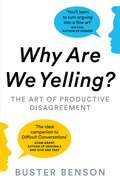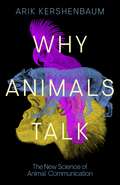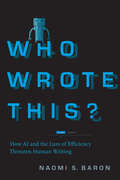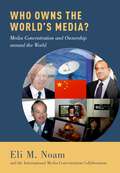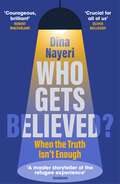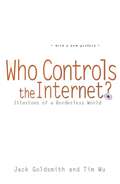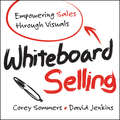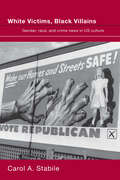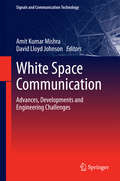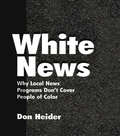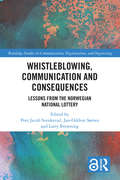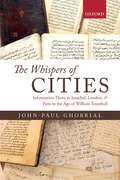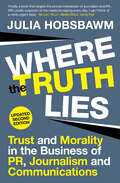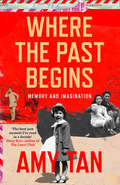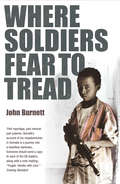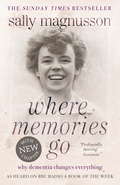- Table View
- List View
Why Are We Yelling: The Art of Productive Disagreement
by Buster BensonWhy Are We Yelling is Buster Benson's essential guide to having more honest and constructive arguments.The way we argue is broken. Whether it’s about Brexit, the existence of ghosts, the best burger in the city or who’s allowed to sit in your favourite chair, we end up digging our heels in and yelling at one another or choosing to avoid heated topics entirely. There has to be a better way.Buster Benson, a Silicon Valley entrepreneur with two decades of experience facilitating hard conversations at some of the biggest tech companies in the world, recommends eight things to try in order to make disagreements more productive. By applying these eight new habits, we can flip frustrating, unproductive disagreements into ones that bear fruit and bring people closer together.In this book you'll master practical skills to make your disagreements more productive by:- Understanding four ways of disagreeing that are more valuable than simply ‘winning’ the argument- Identifying the kind of argument you’re having so you know how best to negotiate it- Articulating the best possible version of your opponent’s argument before attacking itWith this toolkit we can explore more possibilities and perspectives in the world, simply because we’ll no longer be afraid to wade into scary topics of conversation.
Why Animals Talk: The New Science of Animal Communication
by Arik Kershenbaum‘Wonderful . . . Endlessly interesting and beautifully written’ DAILY TELEGRAPH ‘Steady-headed and fun’ SUNDAY TIMES‘Read this book and, I promise, you’ll never listen to animals in the same way again’ JESSICA PIERCE, author of Who’s a Good Dog?Why Animals Talk is a scientific journey through the untamed world of animal communication. From the majestic howls of wolves and the enchanting chatter of parrots to the melodic clicks of dolphins and the spirited grunts of chimpanzees, these diverse and seemingly bizarre expressions are far from mere noise. In fact, they hold secrets that we are just beginning to decipher.For example, wolves – just like humans – possess unique accents that distinguish their howls, and not only do dolphins give themselves names, but they also respond excitedly to recordings of the whistles of long-lost companions.Chapter by chapter and animal by animal, Kershenbaum draws on his extensive research and observations of animals in the wild to explain the science behind why animals are communicating. Also revealing profound insights into our own language and why it is different, Why Animals Talks tells the comprehensive story of communication and how it works across the entire animal kingdom.‘Quirky, insightful . . . based on a deep understanding of recent research’ TIM CLUTTON-BROCK, author of Meerkat Manor‘A new look at a fascinating subject’ DESMOND MORRIS, author of The Naked Ape
Whose Book Is it Anyway?: A View from Elsewhere on Publishing, Copyright and Creativity
by Janis Jefferies And Sarah KemberWhose Book is it Anyway? is a provocative collection of essays that opens out the copyright debate to questions of open access, ethics, and creativity. It includes views – such as artist’s perspectives, writer’s perspectives, feminist, and international perspectives – that are too often marginalized or elided altogether. The diverse range of contributors take various approaches, from the scholarly and the essayistic to the graphic, to explore the future of publishing based on their experiences as publishers, artists, writers and academics. Considering issues such as intellectual property, copyright and comics, digital publishing and remixing, and what it means (not) to say one is an author, these vibrant essays urge us to view central aspects of writing and publishing in a new light. Whose Book is it Anyway? is a timely and varied collection of essays. It asks us to reconceive our understanding of publishing, copyright and open access, and it is essential reading for anyone invested in the future of publishing.
Who Wrote This?: How AI and the Lure of Efficiency Threaten Human Writing
by Naomi S. BaronWould you read this book if a computer wrote it? Would you even know? And why would it matter? Today's eerily impressive artificial intelligence writing tools present us with a crucial challenge: As writers, do we unthinkingly adopt AI's time-saving advantages or do we stop to weigh what we gain and lose when heeding its siren call? To understand how AI is redefining what it means to write and think, linguist and educator Naomi S. Baron leads us on a journey connecting the dots between human literacy and today's technology. From nineteenth-century lessons in composition, to mathematician Alan Turing's work creating a machine for deciphering war-time messages, to contemporary engines like ChatGPT, Baron gives readers a spirited overview of the emergence of both literacy and AI, and a glimpse of their possible future. As the technology becomes increasingly sophisticated and fluent, it's tempting to take the easy way out and let AI do the work for us. Baron cautions that such efficiency isn't always in our interest. As AI plies us with suggestions or full-blown text, we risk losing not just our technical skills but the power of writing as a springboard for personal reflection and unique expression. Funny, informed, and conversational, Who Wrote This? urges us as individuals and as communities to make conscious choices about the extent to which we collaborate with AI. The technology is here to stay. Baron shows us how to work with AI and how to spot where it risks diminishing the valuable cognitive and social benefits of being literate.
Who Wrote This?: How AI and the Lure of Efficiency Threaten Human Writing
by Naomi S. BaronWould you read this book if a computer wrote it? Would you even know? And why would it matter? Today's eerily impressive artificial intelligence writing tools present us with a crucial challenge: As writers, do we unthinkingly adopt AI's time-saving advantages or do we stop to weigh what we gain and lose when heeding its siren call? To understand how AI is redefining what it means to write and think, linguist and educator Naomi S. Baron leads us on a journey connecting the dots between human literacy and today's technology. From nineteenth-century lessons in composition, to mathematician Alan Turing's work creating a machine for deciphering war-time messages, to contemporary engines like ChatGPT, Baron gives readers a spirited overview of the emergence of both literacy and AI, and a glimpse of their possible future. As the technology becomes increasingly sophisticated and fluent, it's tempting to take the easy way out and let AI do the work for us. Baron cautions that such efficiency isn't always in our interest. As AI plies us with suggestions or full-blown text, we risk losing not just our technical skills but the power of writing as a springboard for personal reflection and unique expression. Funny, informed, and conversational, Who Wrote This? urges us as individuals and as communities to make conscious choices about the extent to which we collaborate with AI. The technology is here to stay. Baron shows us how to work with AI and how to spot where it risks diminishing the valuable cognitive and social benefits of being literate.
Who Wants to Marry a Millionaire?: a fun and feisty reality TV romcom
by Joanne BonnyJournalist Emma Fontana is in the middle of setting up a women's magazine called Revolution, when she discovers that her best friends have signed her up for the reality show Who Wants to Marry a Millionaire? For ten days, eligible bachelor Marco Bernardi will host twenty girls in his villa and then choose one of them to be his bride. At first, Emma is furious, and sets off for Como with the intention of discrediting the whole show. But it isn't long before she finds herself caught up in the ridiculous thrill of it all. And then there's Marco's older brother Leonardo, who is as charming as he is suspicious of Emma's real intentions. As her feelings towards the Bernardi brothers become more complicated with each passing day, Emma finds herself wondering: does she want to marry a millionaire?
Who Owns the World's Media?: Media Concentration and Ownership around the World
by Eli M. Noam The International Concentration CollaborationMedia ownership and concentration has major implications for politics, business, culture, regulation, and innovation. It is also a highly contentious subject of public debate in many countries around the world. In Italy, Silvio Berlusconi's companies have dominated Italian politics. Televisa has been accused of taking cash for positive coverage of politicians in Mexico. Even in tiny Iceland, the regulation of media concentration led to that country's first and only public referendum. Who Owns the World's Media? moves beyond the rhetoric of free media and free markets to provide a dispassionate and data-driven analysis of global media ownership trends and their drivers. Based on an extensive data collection effort from scholars around the world, the book covers thirteen media industries, including television, newspapers, book publishing, film, search engines, ISPs, wireless telecommunication and others, across a ten to twenty-five year period in thirty countries. In many countries--like Egypt, China, or Russia--little to no data exists and the publication of these chapters will become authoritative resources on the subject in those regions. After examining each country, Noam and his collaborators offer comparisons and analysis across industries, regions, and development levels. They also calculate overall national concentration trends beyond specific media industries, the market share of individual companies in the overall national media sector, and the size and trends of transnational companies in overall global media. This definitive global study of the extent and impact of media concentration will be an invaluable resource for communications, public policy, law, and business scholars in doing research and also for media, telecom, and IT companies and financial institutions in the private sector.
Who Owns the World's Media?: Media Concentration and Ownership around the World
by Eli M. Noam The International Concentration CollaborationMedia ownership and concentration has major implications for politics, business, culture, regulation, and innovation. It is also a highly contentious subject of public debate in many countries around the world. In Italy, Silvio Berlusconi's companies have dominated Italian politics. Televisa has been accused of taking cash for positive coverage of politicians in Mexico. Even in tiny Iceland, the regulation of media concentration led to that country's first and only public referendum. Who Owns the World's Media? moves beyond the rhetoric of free media and free markets to provide a dispassionate and data-driven analysis of global media ownership trends and their drivers. Based on an extensive data collection effort from scholars around the world, the book covers thirteen media industries, including television, newspapers, book publishing, film, search engines, ISPs, wireless telecommunication and others, across a ten to twenty-five year period in thirty countries. In many countries--like Egypt, China, or Russia--little to no data exists and the publication of these chapters will become authoritative resources on the subject in those regions. After examining each country, Noam and his collaborators offer comparisons and analysis across industries, regions, and development levels. They also calculate overall national concentration trends beyond specific media industries, the market share of individual companies in the overall national media sector, and the size and trends of transnational companies in overall global media. This definitive global study of the extent and impact of media concentration will be an invaluable resource for communications, public policy, law, and business scholars in doing research and also for media, telecom, and IT companies and financial institutions in the private sector.
Who Gets Believed?: When the Truth Isn’t Enough
by Dina NayeriThe prizewinning author of The Ungrateful Refugee asks who is believed in our society, who is not - and why?'Ambitious and moving... it will cement Nayeri's position as a master storyteller of the refugee experience' Guardian Dina Nayeri's wide-ranging, groundbreaking new book combines deep reportage with her own life experience to examine what constitutes believability in our society. Intent on exploring ideas of persuasion and performance, Nayeri takes us behind the scenes in emergency rooms, corporate boardrooms, asylum interviews and into her own family, to ask - where lies the difference between being believed and being dismissed? What does this mean for our culture?As personal as it is profound in its reflections on language, history, morality and compassion, Who Gets Believed? investigates the unspoken social codes that determine how we relate to one another.'An important, courageous, brilliant book' Robert Macfarlane, bestselling author of Underland'Dina Nayeri asks an incredibly important question, and the answers she finds are crucial for all of us' Oliver Bullough, bestselling author of Butler to the World'I was hugely moved by this book. Who Gets Believed? is essential reading, an extraordinary labour of love and hope that is destined to become indispensable in the continuing struggle for justice' John Burnside, winner of the David Cohen Prize for Literature 2023
Who Controls the Internet?: Illusions of a Borderless World
by Jack Goldsmith Tim WuIs the Internet erasing national borders? Will the future of the Net be set by Internet engineers, rogue programmers, the United Nations, or powerful countries? Who's really in control of what's happening on the Net? In this provocative new book, Jack Goldsmith and Tim Wu tell the fascinating story of the Internet's challenge to governmental rule in the 1990s, and the ensuing battles with governments around the world. It's a book about the fate of one idea--that the Internet might liberate us forever from government, borders, and even our physical selves. We learn of Google's struggles with the French government and Yahoo's capitulation to the Chinese regime; of how the European Union sets privacy standards on the Net for the entire world; and of eBay's struggles with fraud and how it slowly learned to trust the FBI. In a decade of events the original vision is uprooted, as governments time and time again assert their power to direct the future of the Internet. The destiny of the Internet over the next decades, argue Goldsmith and Wu, will reflect the interests of powerful nations and the conflicts within and between them. While acknowledging the many attractions of the earliest visions of the Internet, the authors describe the new order, and speaking to both its surprising virtues and unavoidable vices. Far from destroying the Internet, the experience of the last decade has lead to a quiet rediscovery of some of the oldest functions and justifications for territorial government. While territorial governments have unavoidable problems, it has proven hard to replace what legitimacy governments have, and harder yet to replace the system of rule of law that controls the unchecked evils of anarchy. While the Net will change some of the ways that territorial states govern, it will not diminish the oldest and most fundamental roles of government and challenges of governance. Well written and filled with fascinating examples, including colorful portraits of many key players in Internet history, this is a work that is bound to stir heated debate in the cyberspace community.
Who Controls the Internet?: Illusions of a Borderless World
by Jack Goldsmith Tim WuIs the Internet erasing national borders? Will the future of the Net be set by Internet engineers, rogue programmers, the United Nations, or powerful countries? Who's really in control of what's happening on the Net? In this provocative new book, Jack Goldsmith and Tim Wu tell the fascinating story of the Internet's challenge to governmental rule in the 1990s, and the ensuing battles with governments around the world. It's a book about the fate of one idea--that the Internet might liberate us forever from government, borders, and even our physical selves. We learn of Google's struggles with the French government and Yahoo's capitulation to the Chinese regime; of how the European Union sets privacy standards on the Net for the entire world; and of eBay's struggles with fraud and how it slowly learned to trust the FBI. In a decade of events the original vision is uprooted, as governments time and time again assert their power to direct the future of the Internet. The destiny of the Internet over the next decades, argue Goldsmith and Wu, will reflect the interests of powerful nations and the conflicts within and between them. While acknowledging the many attractions of the earliest visions of the Internet, the authors describe the new order, and speaking to both its surprising virtues and unavoidable vices. Far from destroying the Internet, the experience of the last decade has lead to a quiet rediscovery of some of the oldest functions and justifications for territorial government. While territorial governments have unavoidable problems, it has proven hard to replace what legitimacy governments have, and harder yet to replace the system of rule of law that controls the unchecked evils of anarchy. While the Net will change some of the ways that territorial states govern, it will not diminish the oldest and most fundamental roles of government and challenges of governance. Well written and filled with fascinating examples, including colorful portraits of many key players in Internet history, this is a work that is bound to stir heated debate in the cyberspace community.
Whiteboard Selling: Empowering Sales Through Visuals
by Corey Sommers David JenkinsCreate compelling whiteboard presentations to engage your customers and win their business Whiteboard Selling offers a step-by-step approach to transforming your message and selling style by using powerful visual stories that inspire and engage customers and prospects. Free your sales force from relying on slides and other static sales tools during the sales process. Whiteboard Selling offers practical guidance and skills to enable marketing and sales teams to quickly adopt visual story telling practices that apply to today's fast-moving, competitive selling environment. Explains how to take a sales message inventory Illustrates how to design your visual stories Empowers your sales force to tell the story and extend the reach of visual storytelling Through the power of technology and effective storytelling, you and your team can create and deliver effective presentations that engage your customers, hold their attention, and win their business. Whiteboard Selling shows you how.
Whiteboard Selling: Empowering Sales Through Visuals
by Corey Sommers David JenkinsCreate compelling whiteboard presentations to engage your customers and win their business Whiteboard Selling offers a step-by-step approach to transforming your message and selling style by using powerful visual stories that inspire and engage customers and prospects. Free your sales force from relying on slides and other static sales tools during the sales process. Whiteboard Selling offers practical guidance and skills to enable marketing and sales teams to quickly adopt visual story telling practices that apply to today's fast-moving, competitive selling environment. Explains how to take a sales message inventory Illustrates how to design your visual stories Empowers your sales force to tell the story and extend the reach of visual storytelling Through the power of technology and effective storytelling, you and your team can create and deliver effective presentations that engage your customers, hold their attention, and win their business. Whiteboard Selling shows you how.
White Victims, Black Villains: Gender, Race, and Crime News in US Culture
by Carol A. StabileAre all victims white? Are all villains black?White Victims, Black Villains traces how race and gender have combined in news media narratives about crime and violence in US culture. The book argues that the criminalization of African Americans in US culture has been most consistently and effectively legitimized by news media deeply invested in protecting and maintaining white supremacy. An illuminating, and often shocking text, White Victims, Black Villains should be read by anyone interested in race and politics.
White Victims, Black Villains: Gender, Race, and Crime News in US Culture
by Carol A. StabileAre all victims white? Are all villains black?White Victims, Black Villains traces how race and gender have combined in news media narratives about crime and violence in US culture. The book argues that the criminalization of African Americans in US culture has been most consistently and effectively legitimized by news media deeply invested in protecting and maintaining white supremacy. An illuminating, and often shocking text, White Victims, Black Villains should be read by anyone interested in race and politics.
White Space Communication: Advances, Developments and Engineering Challenges (Signals and Communication Technology)
by Amit Kumar Mishra David Lloyd JohnsonThis monograph presents a collection of major developments leading toward the implementation of white space technology - an emerging wireless standard for using wireless spectrum in locations where it is unused by licensed users. Some of the key research areas in the field are covered. These include emerging standards, technical insights from early pilots and simulations, software defined radio platforms, geo-location spectrum databases and current white space spectrum usage in India and South Africa.
White News: Why Local News Programs Don't Cover People of Color (Routledge Communication Series)
by Don HeiderIs TV news racist? If the purpose of local news is to cover individual communities and to present issues of interest and concern to local audiences, why are local newscasts so similar in markets around the country? These are the questions that motivated Heider's research, leading to the development of this book. Recognizing that local news is the outlet through which most people get their news, Heider ventured into the local television newsrooms in two moderate-size, culturally diverse U.S. markets to observe the news process. In this report, he uses his insider's perspective to examine why local television news coverage of people of color does not occur in more meaningful ways. Heider examines the perceptions of racism and ethnicity, and addresses such dichotomies as "white" news (content determined by white managers) being delivered by non-white news anchors, thus giving the appearance of "non-white" news. He also considers how coverage of minorities influences viewers' perceptions of their minority neighbors. Heider then sets forth a new theoretical concept--incognizant racism--as a way of explaining how news workers consistently ignore news in significant portions of the communities they cover. This contribution to the minorities and media discussion provides important insights into the newsroom decision-making process and the sociology and structure of newsrooms. It is required reading for all who are involved in news reporting, mass communication, media and minority studies, and cultural issues in today's society.
White News: Why Local News Programs Don't Cover People of Color (Routledge Communication Series)
by Don HeiderIs TV news racist? If the purpose of local news is to cover individual communities and to present issues of interest and concern to local audiences, why are local newscasts so similar in markets around the country? These are the questions that motivated Heider's research, leading to the development of this book. Recognizing that local news is the outlet through which most people get their news, Heider ventured into the local television newsrooms in two moderate-size, culturally diverse U.S. markets to observe the news process. In this report, he uses his insider's perspective to examine why local television news coverage of people of color does not occur in more meaningful ways. Heider examines the perceptions of racism and ethnicity, and addresses such dichotomies as "white" news (content determined by white managers) being delivered by non-white news anchors, thus giving the appearance of "non-white" news. He also considers how coverage of minorities influences viewers' perceptions of their minority neighbors. Heider then sets forth a new theoretical concept--incognizant racism--as a way of explaining how news workers consistently ignore news in significant portions of the communities they cover. This contribution to the minorities and media discussion provides important insights into the newsroom decision-making process and the sociology and structure of newsrooms. It is required reading for all who are involved in news reporting, mass communication, media and minority studies, and cultural issues in today's society.
Whistleblowing, Communication and Consequences: Lessons from The Norwegian National Lottery (Routledge Studies in Communication, Organization, and Organizing)
by Peer Jacob Svenkerud; Jan-Oddvar Sørnes; Larry BrowningWhistleblowing, Communication and Consequences offers the first in-depth analysis of the most publicized, and morally complex, case of whistleblowing in recent European history: the Norwegian national lottery, Norsk Tipping. With contributions from the whistleblower himself, as well as from key voices in the field, this book offers unique perspectives and insights into not only this fascinating case, but into whistleblowing and wrongdoing in organizations more broadly. An international team of scholars use fourteen different theoretical lenses to show the complex and multi-faceted nature of whistleblowing. The book begins with an ethnographic account by the whistleblower story and proceeds into an analysis of the literature and conceptual topics related to that whistleblowing incident to present the lessons that can be learnt from this extreme example of institutional failure. This fascinating, complex, and multi-theoretical book will be of great interest to scholars, students and industry leaders in the areas of public relations, corporate communication, leadership, corporate social responsibility, whistleblowing and organizational resistance.
Whistleblowing, Communication and Consequences: Lessons from The Norwegian National Lottery (Routledge Studies in Communication, Organization, and Organizing)
by Peer Jacob Svenkerud Jan-Oddvar Sørnes Larry BrowningWhistleblowing, Communication and Consequences offers the first in-depth analysis of the most publicized, and morally complex, case of whistleblowing in recent European history: the Norwegian national lottery, Norsk Tipping. With contributions from the whistleblower himself, as well as from key voices in the field, this book offers unique perspectives and insights into not only this fascinating case, but into whistleblowing and wrongdoing in organizations more broadly. An international team of scholars use fourteen different theoretical lenses to show the complex and multi-faceted nature of whistleblowing. The book begins with an ethnographic account by the whistleblower story and proceeds into an analysis of the literature and conceptual topics related to that whistleblowing incident to present the lessons that can be learnt from this extreme example of institutional failure. This fascinating, complex, and multi-theoretical book will be of great interest to scholars, students and industry leaders in the areas of public relations, corporate communication, leadership, corporate social responsibility, whistleblowing and organizational resistance.
The Whispers Of Cities: Information Flows In Istanbul, London, And Paris In The Age Of William Trumbull
by John-Paul A. GhobrialIn recent years, global historians have painted an impressionistic picture of what they call the 'connected world' of the seventeenth century. Inspired perhaps by the globalised world in which they write, scholars have emphasised how the circulation of people, objects, and ideas linked the distant reaches of the early modern world. Yet for all the advocates of such a 'connected history', we are only beginning to make sense of what global connectedness meant in practice in the lives of ordinary people. To this end, The Whispers of Cities explores interactions between early modern Europe and the Ottoman Empire through the kaleidoscope of communication. It does so by focusing on how information flows linked Istanbul, London, and Paris in the late seventeenth century. Because individuals were at the heart of communication, the book offers a micro-historical reading of the experiences of Sir William Trumbull, English ambassador to Istanbul from 1687 to 1692. It follows Trumbull as he was transformed from a civil lawyer and state official in London to a European notable at the heart of Ottoman social networks in Istanbul. In this way, The Whispers of Cities reveals how information flows between Istanbul, London, and Paris were rooted in the personal encounters that took place between Ottomans and Europeans in everyday communication. At the intersection of global history and the history of communication, therefore, the author argues that worlds of information tied Europeans to their Ottoman counterparts long before the age of modernisation, as news, stories, and even fictions transcended linguistic and confessional boundaries and connected people across Europe and the Mediterranean world. What emerges here is a picture of globalization that is as much about networks, flows, and circulation as it is about the imperfections, asymmetries, and unevenness of connectedness in the early modern world.
Where the Truth Lies: Morality And Trust In Pr And Journalism
by Julia HobsbawmThe relationship between the serious news media and the truth is under scrutiny as never before. In recent years the BBC and the New York Times have been knocked sideways by scandals alleging exaggeration and distortion. At the same time, the influence of the PR industry continues to expand, so that no organisation that is serious about communicating its message can be without a PR strategy. In a series of wide-ranging essays about public relations and journalism, Where the Truth Lies tackles head-on issues as diverse as the public role of PR, the reportage of crises and the role of 'new' media. It also includes Julia Hobsbawm's four point plan to remake the relationship between PR and journalism. Contributors include John Lloyd, Simon Jenkins, Peter Oborne, Mark Borkowski and Janine di Giovanni.
Where the Past Begins: A Writer's Memoir
by Amy TanFrom New York Times bestselling author Amy Tan, a memoir on her life as a writer, her childhood and the symbiotic relationship between fiction and emotional memory.
Where Soldiers Fear To Tread: At Work in the Fields of Anarchy
by John BurnettIn 1998, on the lookout for adventure and willing to take a risk, John Burnett left the comforts of the mainstream and became a UN relief worker in Somalia. He was completely unprepared for the realities of working in a country without government or law, where the only authority comes from a loaded gun. Held at gunpoint by a child soldier, having to watching a baby die of malaria in his arms, the experience profoundly changed the way he saw the world.
Where Memories Go: Why dementia changes everything - Now with a new chapter
by Sally Magnusson'A fine book' The Sunday Times 'Powerful' Guardian 'Wonderful' The Telegraph'Moving, funny, warm' Mail on Sunday'Brave, compassionate, tender and honest' Metro'This book began as an attempt to hold on to my witty, storytelling mother with the one thing I had to hand. Words. Then, as the enormity of the social crisis my family was part of began to dawn, I wrote with the thought that other forgotten lives might be nudged into the light along with hers. Dementia is one of the greatest social, medical, economic, scientific, philosophical and moral challenges of our times. I am a reporter. It became the biggest story of my life.' Sally MagnussonSad and funny, wise and honest, Where Memories Go is a deeply intimate account of insidious losses and unexpected joys in the terrible face of dementia, and a call to arms that challenges us all to think differently about how we care for our loved ones when they need us most.Regarded as one of the finest journalists of her generation, Mamie Baird Magnusson's whole life was a celebration of words - words that she fought to retain in the grip of a disease which is fast becoming the scourge of the 21st century. Married to writer and broadcaster Magnus Magnusson, they had five children of whom Sally is the eldest. As well as chronicling the anguish, the frustrations and the unexpected laughs and joys that she and her sisters experienced while accompanying their beloved mother on the long dementia road for eight years until her death in 2012, Sally Magnusson seeks understanding from a range of experts and asks penetrating questions about how we treat older people, how we can face one of the greatest social, medical, economic and moral challenges of our times, and what it means to be human.Facebook.com/WhereMemoriesGo
